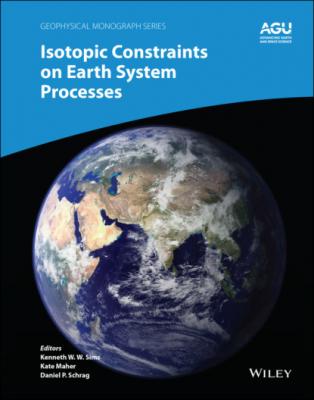Isotopic Constraints on Earth System Processes. Группа авторов
Чтение книги онлайн.
Читать онлайн книгу Isotopic Constraints on Earth System Processes - Группа авторов страница 36
 to the data."/>
to the data."/>
Figure 2.7 The modified EBD model applied to the data. Top panels: SiO2 diffusion is well‐approximated as effective binary in an infinite medium. Middle panels: Both CaO and K2O exhibit uphill diffusion, which is attributed in the model to transient partitioning between high‐silica and low‐silica liquids. Bottom panels: Despite the simplifying assumptions, the model captures the sign and magnitude of diffusive isotope effects.
Model for the Isotope Ratio Profiles
Model isotope ratio profiles are generated by invoking a difference in diffusivity between the isotopes of an element. The dependence of diffusivity on mass can be written as (Richter et al., 1999):
(2.9)
where β is a dimensionless empirical parameter. Here, m refers to the isotopic mass and not the mass of an isotopically substituted molecule such as, for example, CaAl2O4. This functional form is based on principles from the kinetic theory of gases, but it’s also convenient because it normalizes out the fractional mass difference between isotopes, thereby allowing for direct comparison between different isotopic systems.
To model the isotope ratio profiles, we assume the rhyolite and phonolite have the same isotopic composition since they are within error of each other with respect to δ 44Ca. Although we did not directly measure the δ 41K of either starting material, the assumption that they are the same can be justified on the basis that the global range in δ 41K of igneous rocks and minerals is < 1‰ (Morgan et al., 2018). We assume further that the equilibrium isotope ratio profile is uniform at all times; i.e., Ce, 44 is defined to be proportional to Ce, 40 such that the ratio Ce, 44/Ce, 40 is constant, which implies that there is no equilibrium isotopic partitioning between the liquids. Hence, any isotopic fractionations in the model arise solely from diffusive fluxes and the difference in isotopic diffusion coefficients.
Model isotopic profiles are compared to the data in the bottom panels of Fig. 2.7. For Ca isotopes, no single set of parameters (
2.5.3. Comparison to Previous Studies
It was shown previously that β factors correlate with the diffusivity of the cation normalized by that of Si (or SiO2) (Fig. 2.8). Since Si is strongly bound in multi‐atom complexes with O (as well as Al and other Si atoms), it diffuses more slowly than other elements, and hence the ratio Di/DSi is generally greater than unity. For elements present in major quantities, the ratio Di/DSi is typically close to unity because of the cooperative motion that is required to yield a net flux of counter‐diffusing major elements. The regime where Di/DSi is high tends to occur in more silica‐rich liquids and with decreasing temperature (Dingwell, 1990).
Figure 2.8 β factors from this study (points with an asterisk) compared to literature values. The quantity
The ratio
2.6. CONCLUSIONS AND POSSIBLE FUTURE APPLICATIONS
We performed a set of diffusion couple experiments involving unusual phonolite and rhyolite compositions. The data and analysis of those experiments presented here provides additional β factors needed for modeling reaction and transport processes in high temperature geologic systems. Despite the complicated nature of the diffusion profiles, which is an inevitability when dealing with natural silicate liquid compositions, we showed how one can extract a meaningful β factor from the diffusion profiles using a modified effective binary diffusion model that was first developed by Zhang (1993). Our results confirm that β factors vary depending on the element as well as liquid composition, and also that large diffusive isotope effects can arise even in the absence of a large initial concentration gradient. The retrieved β factor for Ca is typical of Ca in natural silicate liquids whereas the β factor for K is the highest value yet reported, suggesting that large diffusive K isotope effects may yet be found in high‐T environments.
One of the goals of this type of experimental study is to use the growing compilation of β factors to better understand how the mobility of key chemical constituents is controlled, and how that mobility relates to isotopic fractionation of Ca, Mg, Fe, Si, and K in high temperature systems. Recent work shows how isotopic effects in these elements can be used as tracers of micro‐ and nano‐scale processes at mineral surfaces and transport within geologic media at larger scales. For example, Antonelli et al. (2019a) documented small Ca isotope fractionations between